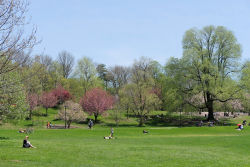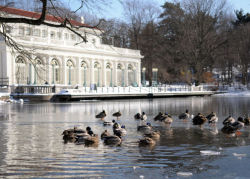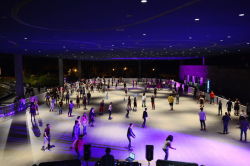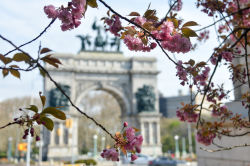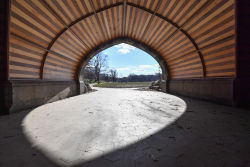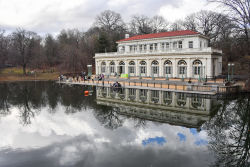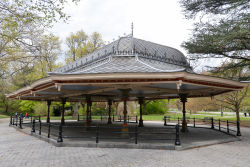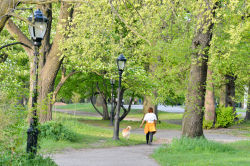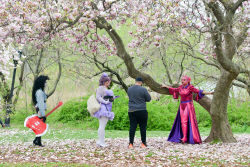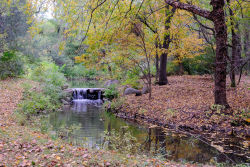Prospect Park
Carl Maria Von Weber Statue
This bronze bust of the German composer Carl Maria Friedrich Ernst von Weber (1786-1826) was created by sculptor Chester Beach (1881–1956). Installed in the Concert Grove in 1909, the statue is one of seven in the immediate vicinity, including four portraits of composers.
Born in Eutin, Germany, von Weber was a leading figure in the development of Romantic music. The son of a stage manager, von Weber was exposed to the theater at an early age and it exerted a huge influence later on his operatic compositions. A distant relation of Mozart, he studied composition in Salzburg at an early age, and was taught by Michael Haydn, the brother of Joseph Haydn. He published six miniature fugues at the age of 12, and completed his first opera (now lost) the following year.
In 1804, von Weber was appointed conductor at Breslau (now Wroclaw), and in 1806, he became musical director for Duke Eugen of Wurttemberg, gaining a reputation as an exceptional pianist. From 1813 to 1816 he conducted in Prague, and from 1817 to 1826 in Dresden. In 1821 he debuted his opera, Der Freischutz (The Marksman), in Berlin. Based on the traditional German folk story of a hunter who is given seven charmed bullets by the devil, it is often considered his masterpiece. His other operas include Euryanthe (1823) and Oberon (1826).
Von Weber established a distinctly German operatic idiom, influencing many composers who followed him, most noticeably Richard Wagner (1813–1883). He was one of the earliest proponents of the leitmotif, a musical theme that recurs throughout an opera, coinciding with each appearance of a given character, emotion or thought. He also composed orchestral works, chamber music, and piano works, including the famous Invitation to the Dance (1819). Just two months after the premiere of his opera Oberon, Weber died of consumption in London. He is buried in Dresden.
Frederick Law Olmsted’s (1822-1903) and Calvert Vaux’s (1824-1895) original 1866 plan for Prospect Park, indicated no detailed plan for this section of the property. They merely wrote that this area should be a “Concourse for Pedestrians” and contain a “Music Stand.” With the park under construction around 1870, Olmsted and Vaux elaborated on their design to accommodate a space for musical performances. Within an otherwise pastoral park, they set formal grounds with terraces and a radial arrangement of walkways, punctuated by lineally arranged trees, lavish floral beds and elaborate decorative carvings in New Brunswick sandstone. Noting that, “Promenade concerts are common in many European pleasure grounds [and were] universal in German towns, common in French, and less so in British,” they sought to create a similar effect in the Concert Grove.
The Concert Grove House, demolished in 1949, originally stood at the North End of the grove, and at the south end Vaux designed the Concert Grove Pavilion. Completed in 1874, the pavilion is made of eight cast-iron posts modeled after Hindu columns of the medieval period (8th to 12th centuries), supporting an elaborately painted, hipped roof with stained-glass cupola. The structure—restored in 1987—is also known as the Oriental Pavilion. At one time it was used as an open-air restaurant.
In 1887, the Music Pagoda was built near the Lily Pond, and with the subsequent establishment of a new music grove at the north edge of the area of the park known as the Nethermead, this area came to be referred to as the Flower Garden.
The Concert Grove possesses a rich collection of bronze sculptural portraits. Three—including this one—were donated by the United German Singers of Brooklyn as trophies which they had won in the national Saengerfest (singing festival) choral competitions; the other two are Henry Baerer’s bust of Ludwig van Beethoven (1894) and Augustus Mueller’s Wolfgang Amadeus Mozart (1897). The portrait of von Weber was originally won in the 22nd Saengerfest held in New York on June 22, 1907. It was presented two years later as a gift to the Borough of Brooklyn and installed on its tapered granite pedestal. The sculpture was conserved in 1997 by the City Parks Foundation Monuments Conservation Program, with funding from the Florence Gould Foundation.
Check out your park's Vital Signs
Clean & Safe
Green & Resilient
Empowered & Engaged Users
Share your feedback or learn more about how this park is part of a
Vital Park System


